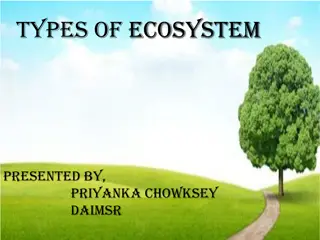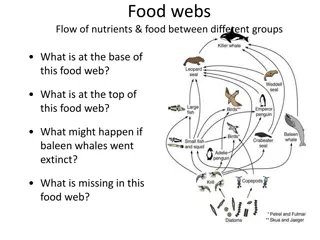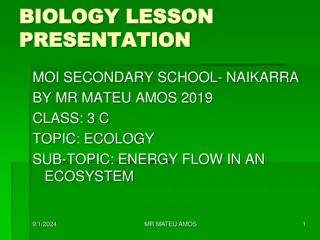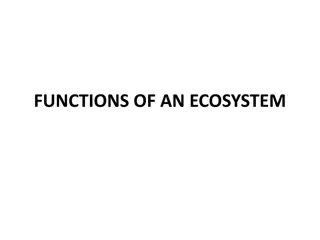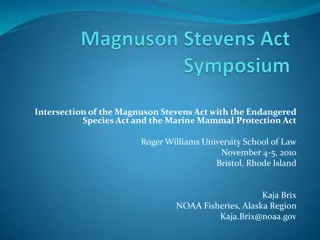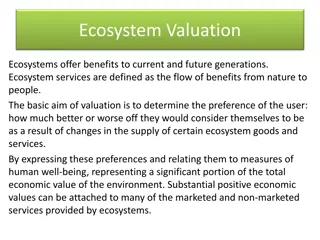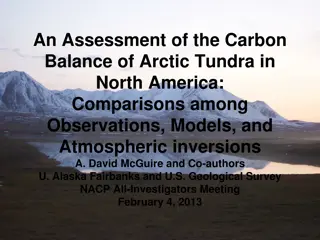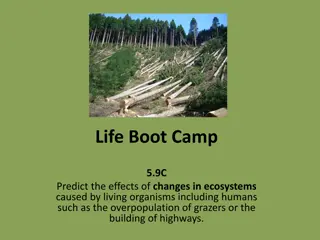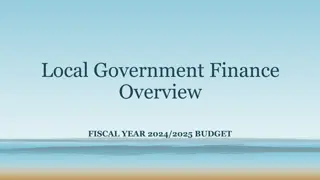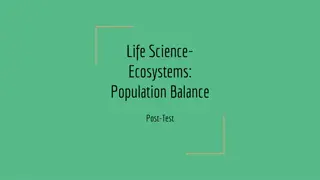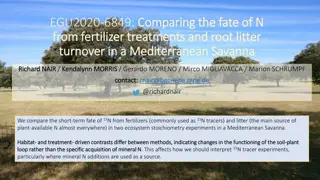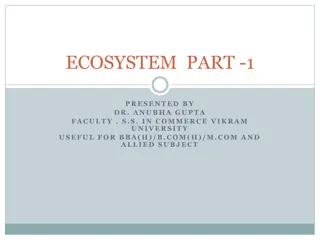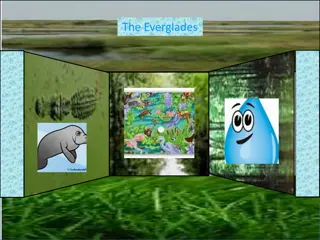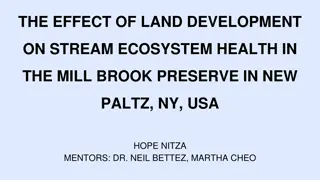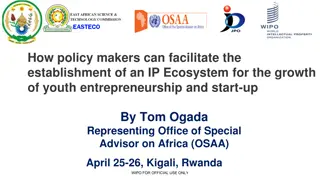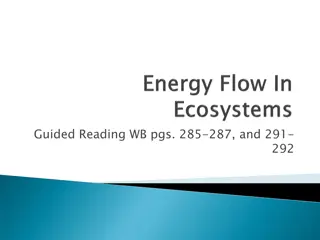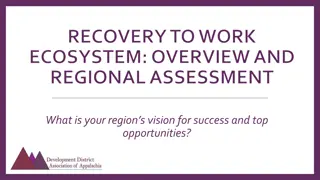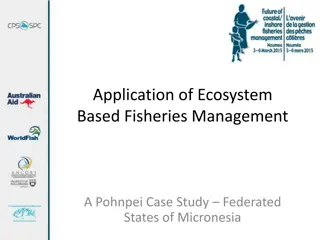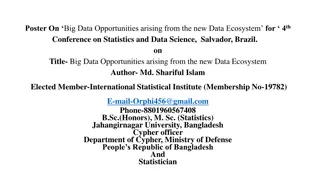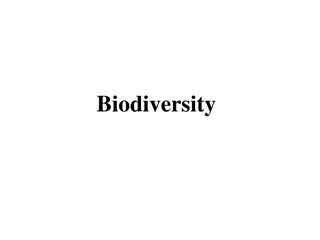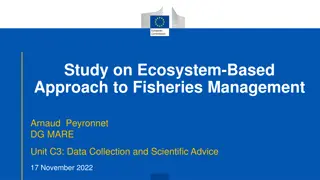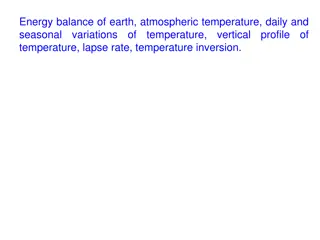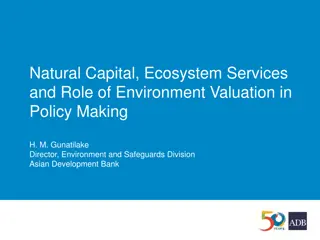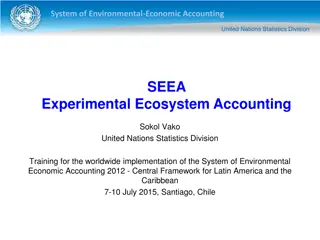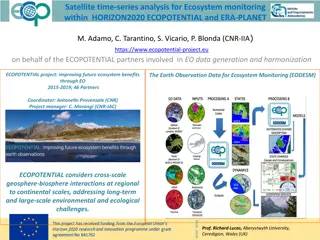Social Balance Theory and Network Interactions
Explore social balance theory and its application in network interactions, based on chapters 10 and 11 of "Networks, Crowds, and Markets" by D. Easley and J. Kleinberg. Learn about global balance index, exchange cost, social power, network building algorithm, random and scale-free networks, matching
3 views • 27 slides
Exploring Different Ecosystem Types and Functions
Learn about the major types of ecosystems such as Grassland, Aquatic, Forest, and Desert presented by Priyanka Chowksey of DAIMSR. Understand the components of an ecosystem, including biotic and abiotic factors, and the significance of different ecosystems like Forest Ecosystem and Desert Ecosystem.
4 views • 29 slides
An Ecosystem Services Approach to Water Resources
Discover the world of ecosystem services through mapping and classifying services provided by different landscapes using Google Earth. Learn how to link Google Earth to photographs and investigate various features to understand the production of ecosystem services over time.
2 views • 15 slides
Overview of O-RAN SC Bronze Release Objectives and Timelines
The content delves into the objectives of the OSC Bronze release focusing on end-to-end RAN communications and traffic steering use cases. It highlights the key elements of the Bronze release like health checks, RAN ecosystem connectivity, and timelines for bi-annual releases. Additionally, it discu
0 views • 18 slides
Understanding Off-Balance Sheet Items in Banking Activities
Off-balance sheet items refer to activities that are assets or liabilities of a company but do not appear on the balance sheet. In banking, these can include loans given to borrowers, securitization, guarantees, and other contingent facilities. Learn more about how off-balance sheet exposures impact
0 views • 6 slides
Benefits of Mycorrhizae in Plant Nutrition and Ecosystem Health
Mycorrhizae play a crucial role in enhancing plant nutrient uptake, protecting against pests, improving plant growth, and fostering ecosystem stability. These symbiotic relationships provide various benefits such as increased nutrient supply, protection from pathogens, enhancement of plant growth fo
0 views • 9 slides
Understanding the Urinary System: Kidneys, Functions, and Structure
The urinary system, also known as the renal system, consists of the kidneys, ureters, bladder, and urethra. Each kidney contains nephrons, the functional units responsible for filtering waste and regulating blood volume, pressure, electrolytes, and pH balance. The kidneys have an extensive blood sup
0 views • 35 slides
Role of Major Physiological Anions in the Human Body
Physiological anions such as chlorides, sulphates, bicarbonate, phosphates, and electrolytes play essential roles in maintaining various functions within the body. Chloride ions help in osmotic balance, charge balance, and acid-base balance. Sulphates are important for detoxification mechanisms and
0 views • 11 slides
Understanding Food Webs and Trophic Levels in Ecosystems
Food webs illustrate the flow of nutrients and energy between different organisms in an ecosystem. At the base of a food web are the primary producers, while predators occupy the top. If baleen whales were to go extinct, it could disrupt the balance of their ecosystem. Biomass decreases as energy is
0 views • 11 slides
Understanding Energy Flow in Ecosystems: A Comprehensive Overview
Energy flow in an ecosystem involves the transfer of energy from producers to consumers through different trophic levels, with only a small fraction of energy being passed on at each level. This process is essential for sustaining life within an ecosystem, highlighting the interconnectedness of all
0 views • 11 slides
Understanding the Key Functions of an Ecosystem
Ecosystem functions are vital for the survival of various components within them, with energy flow, nutrient circulation, and biogeochemical cycles playing significant roles. Energy flow starts with solar radiation and sustains producers, consumers, and decomposers, highlighting the interconnectedne
0 views • 21 slides
Ecosystem Considerations in Fisheries Management Laws
Analysis of the intersection of the Magnuson Stevens Act, Endangered Species Act, and Marine Mammal Protection Act in addressing ecosystem considerations within fisheries management. Evaluation of current regulatory frameworks and the need for an ecosystem-based approach towards fisheries and apex p
0 views • 15 slides
Exploring Ecosystem Dynamics: Food Chains, Energy Pyramids, and Trophic Levels
An exploration of key concepts in ecosystem dynamics, including food chains, energy pyramids, secondary consumers, and trophic levels. Discover the interconnected relationships between organisms in an ecosystem and the vital role of key species. Dive into the differences between food chains and food
0 views • 16 slides
Understanding Ecosystem Valuation and Non-Market Techniques
Ecosystem valuation aims to assess user preferences for ecosystem goods and services, determining the economic value attached to nature's benefits. Ecosystems offer provisioning, regulating, cultural, and supporting services crucial for human well-being. Various non-market valuation techniques like
0 views • 5 slides
Understanding Water and Electrolyte Balance in the Human Body
The body's fluid compartments, including intracellular and extracellular fluids, play a crucial role in maintaining water and electrolyte balance. This balance is regulated by movements of water and electrolytes between compartments, influenced by factors like hydrostatic and osmotic pressures. Main
2 views • 18 slides
Carbon Balance of Arctic Tundra in North America: An Overview
This assessment delves into the carbon balance of Arctic tundra in North America, comparing observations, models, and atmospheric inversions. Co-authored by researchers from various institutions, the study analyzes data from 1960 onwards, addressing the changing CO2 sink in high latitudes. It evalua
0 views • 17 slides
Understanding Ecosystem Changes Caused by Living Organisms
Explore the effects of changes in ecosystems caused by living organisms, including humans, such as the overpopulation of grazers or the introduction of invasive species like kudzu. Learn how these factors impact native plants, water supply, weather patterns, and the balance of organisms within ecosy
0 views • 97 slides
Understanding Fund Balance in School Finance
Explore the concept of fund balance in school finance through examples from Bozeman Schools. Learn how beginning balance, revenues, and expenditures affect the ending fund balance, with a system designed to maintain reserves. Delve into budgeting and actual expenditure scenarios to better comprehend
0 views • 24 slides
Local Government Finance Overview - Fiscal Year 2024/2025 Budget Insights
Explore the Fiscal Year 2024/2025 Budget details including Fund Balance, Revenue sources, Importance of a Strong Fund Balance, Fund Balance Policies, various Funds available, Revenues breakdown by types, and Actuals data for the year 2022/2023. Understand the significance of maintaining a strong Fun
0 views • 27 slides
Understanding Posture, Balance, and Gait Analysis in Human Movement
This resource delves into the static assessment of posture and balance, exploring the various inputs and control mechanisms involved in maintaining standing posture. It discusses the key factors influencing posture, such as visual, somatosensory, proprioceptive, and vestibular systems, along with mu
0 views • 51 slides
Understanding Balance of Payment (BOP) and Its Components
Balance of Payments (BOP) is a crucial accounting record detailing a country's economic transactions with the rest of the world. It encompasses exports, imports, financial transfers, and more. The BOP consists of the Current Account Balance, Capital Account Balance, and Overall BOP, reflecting the f
0 views • 17 slides
Ecosystems and Population Balance Test Questions
Explore questions related to ecosystems, population balance, biodiversity, and the impact of species introduction on native populations. Topics include energy flow in food chains, the importance of biodiversity, the succession of events in a garden ecosystem, and the effects of human activities on w
0 views • 6 slides
Understanding Balance of Power in 18th Century Europe
Balance of power in 18th-century Europe was a concept where great powers aimed to maintain equilibrium to prevent one nation from becoming too powerful. This balance was evident in events like the War of the Austrian Succession and the Diplomatic Revolution of 1756, which reshaped alliances and riva
0 views • 13 slides
Understanding Nitrogen Dynamics in a Mediterranean Savanna Ecosystem
Investigating the fate of nitrogen from fertilizer treatments and root litter turnover in a Mediterranean Savanna ecosystem. The study compares the short-term fate of 15N tracers in ecosystem stoichiometry experiments, highlighting changes in soil-plant functioning. The research addresses N turnover
0 views • 10 slides
Understanding the Impact of Invasive Species in Wilderness Management
Invasive species pose a significant threat to the ecosystem by causing disruptions in biodiversity and ecosystem health. This article discusses the importance of managing invasive species in wilderness areas and provides insights into creating successful Invasive Species Plans. It sheds light on the
0 views • 22 slides
Understanding Ecosystems: Components and Interactions
An ecosystem, as explained by Dr. Anubha Gupta from Vikram University, is a community of living organisms and their nonliving environment components working together. The ecosystem comprises biotic and abiotic elements, with producers, consumers, and decomposers playing vital roles in maintaining ba
0 views • 12 slides
Discovering the Diverse Ecosystem of the Everglades
The Everglades ecosystem in southern Florida is unique, offering a mix of temperate and tropical zones that support a wide variety of flora and fauna. Home to endangered species like the Florida panther and American crocodile, the region's wet climate and sawgrass landscapes make it a crucial habita
0 views • 4 slides
Impact of Land Development on Stream Ecosystem Health in Mill Brook Preserve, NY, USA
The study focuses on the effects of land development on stream ecosystem health in the Mill Brook Preserve in New Paltz, NY. It discusses the degradation of water quality due to surrounding land development and the importance of macroinvertebrates as indicators of ecosystem health. The review of lit
0 views • 23 slides
Facilitating an Intellectual Property Ecosystem for Youth Entrepreneurship Growth
In order to facilitate the establishment of an intellectual property ecosystem for the growth of youth entrepreneurship and start-ups, policy makers can take various interventions including revisiting the IP ecosystem, the need for evidence-based decision making, development of startups policies and
0 views • 9 slides
Revolutionizing Drone Operations with Windhover Ecosystem
Windhover Ecosystem, developed through NASA SBIR Phase I and II, offers a robust and open-source software solution for drone operations. The ecosystem includes integrated flight and ground control software, providing scriptable flight control, rapid prototyping, and full autonomy capabilities. Lever
0 views • 23 slides
Understanding Energy Roles in Ecosystems
Organisms in an ecosystem play essential roles in the movement of energy, with each having a specific function. Energy roles include producers, consumers, and decomposers, each contributing to the balance of energy flow and nutrient cycling. Producers, such as plants, algae, and some bacteria, creat
0 views • 36 slides
Regional Recovery to Work Ecosystem Assessment and Goals
In this assessment, the focus is on the vision for success and top opportunities within the Recovery to Work Ecosystem. Goals include organizing stakeholders, engaging and supporting businesses, and providing wrap-around support for jobseekers. The discussions cover collaborative efforts, strengths,
0 views • 8 slides
Ecosystem-Based Fisheries Management in Pohnpei: A Case Study
The application of ecosystem-based fisheries management in Pohnpei, Federated States of Micronesia, involves a top-down regulatory history followed by a bottom-up approach focusing on the establishment of marine protected areas. The characteristics of Pohnpei's coral reef fisheries show declines in
0 views • 18 slides
Big Data Opportunities in the New Data Ecosystem
A data ecosystem encompasses infrastructure, analytics, and data analysis, fostering partnerships and coordination to leverage the power of data. This ecosystem, driven by Big Data technologies and deep analytical talent, aims to address complex business challenges and drive innovation. The integrat
0 views • 5 slides
Understanding Biodiversity: Importance and Implications
Biodiversity encompasses the variety of plant and animal life on Earth, including genetic, species, and ecosystem diversity. It plays a crucial role in maintaining ecological balance and ecosystem processes. Traits and interactions among species influence ecosystem function, emphasizing the signific
0 views • 14 slides
Ecosystem-Based Approach to Fisheries Management Study Overview
The study focuses on assessing the current state of implementing Ecosystem-Based Approach to Fisheries Management (EAFM) within the EU, providing recommendations to address challenges and advance towards the objectives of the Common Fisheries Policy (CFP). It outlines a systematic evaluation of exis
0 views • 24 slides
Understanding Earth's Energy Balance and Temperature Variations
Earth's energy balance is crucial for maintaining atmospheric temperature and regulating daily and seasonal temperature changes. The net radiation, consisting of incoming shortwave and outgoing longwave radiation, plays a key role in this balance. Components such as sensible heat flux, latent heat o
0 views • 18 slides
Understanding Natural Capital and Ecosystem Services Valuation for Effective Policy Making
Natural capital and ecosystem services play a crucial role in shaping policies related to environmental conservation and resource management. Valuing ecosystem services helps assess human welfare impacts and address market failures in allocating resources. Issues such as land degradation and loss of
0 views • 24 slides
System of Environmental-Economic Accounting and Experimental Ecosystem Accounting Overview
The System of Environmental-Economic Accounting (SEEA) and Experimental Ecosystem Accounting aim to integrate biophysical data, monitor ecosystem changes, and link them to economic activities. They provide a framework for accounting for ecosystem assets and services, playing a crucial role in the po
0 views • 34 slides
Satellite Time-Series Analysis for Ecosystem Monitoring in ECOPOTENTIAL Project
This project, part of HORIZON2020 and ERA-PLANET, focuses on satellite time-series analysis for ecosystem monitoring at regional to continental scales. It aims to improve ecosystem benefits through Earth Observation data, contributing to UN Sustainable Development Goal 15 by protecting, restoring, a
0 views • 19 slides

